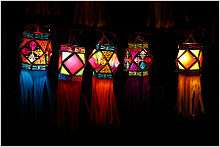Kandeel

A kandeel is a lantern with a wooden framework and covered in coloured matte or glossy papers. These lanterns are generally hung in front of homes during the Hindu festival of lights, Diwali. Kandeel in Sanskrit is known as akasha deepa (lantern of the sky) and in Kannada, Goodu Deepa (nested light), or Nakshatra Gudu (star-like nest). Hindus in earlier days set kandeels afloat high, a gesture to invite the spirits of their ancestors moving around to come back home and be with them during the festival time; hence the name akasha deepa (lantern of the sky) or AkashaKandil.
In Kerala, especially in Fort Kochi, a city in Ernakulam District, it is known as akasha vilakku. Hindu Vaishyas (Konkani-speaking linguistic minority of Kerala), who had skulked out from Goa during the Portuguese regime, dwelt in Kerala. During the Hindu lunar month of 'Kartika', the people use to put akasha deepam, colloquially known in Konkani dialect "Panjire", in place on roof tops of the houses and light them in the evening until dawn breaks in and up to the Karthika Paurnami (full moon) day or Dev Dewali day. Earlier oil lamps were used, which are fixed in the panjire (cage models), now colourful electrical lights are used instead. By lighting the panjiras it is believed that during Kartika those who had died used to visit their houses and wish their relatives wellbeing, or if the lights were not lit in front of the house, the curses them to live them in darkness in life.
Kandeels are hung for around a month from the first day of Diwali. Kandeels are traditionally built in a crystal shape with tails at the bottom; shapes include stars, globes and airplanes. Opaque papers cut into a complex design give more beauty to a Kandeel by blocking some of the light behind it.